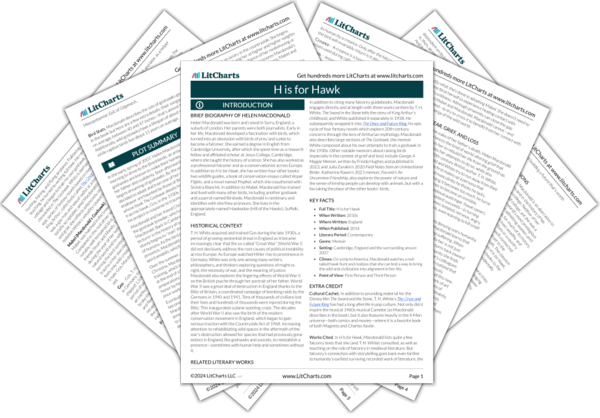Living with the Wild
H Is for Hawk starts with Helen Macdonald at a transition point in her life. Even before her father’s unexpected death, she’s almost done with her university teaching job and unsure where to go next. To soothe her troubled spirit, she heads to the Brecklands—one of the wildest parts of England—to watch for goshawks—one of the wildest and most reclusive birds in England. Adopting Mabel, her own fledgling goshawk, thus represents Macdonald’s attempt…
read analysis of Living with the WildFear, Grief, and Loss
In the wake of her father’s death, Helen Macdonald experiences the kind of world-altering grief that requires her to rebuild her life from the ground up. H Is for Hawk describes her attempts to do so, while also exploring the life of 20th-century British author T. H. White. Initially, both Macdonald and White try to run away from their pain and suffering. White first makes up a persona that possesses the bravado and masculinity…
read analysis of Fear, Grief, and LossLove, Trust, and Freedom
The last wild goshawk in Britian was shot down as a pest sometime in the 19th century, but falconers were able to reintroduce the birds to the wild in the 1960s and 1970s by importing them from other countries and releasing them into the wild. This is because even though people like Stuart, Helen Macdonald and T. H. White can accustom birds to tolerate and work with humans, birds of prey cannot be domesticated—they…
read analysis of Love, Trust, and Freedom
Time and History
Because falconry is an ancient art, practicing it tends to collapse time in on itself. This is, in fact, part of the appeal for both Helen Macdonald and T. H. White—at least insofar as Macdonald interprets White’s life for readers. She pictures him feeling so alienated and unloved in his 1930s present that he used falconry to imagine himself into an ancient world where he might have been loved and respected. Similarly, he uses…
read analysis of Time and History







Social Divisions
In many ways, Helen Macdonald is an aberration in the history of falconry and in the history of her Cambridge University college. Neither of her working-class parents ever attended college, yet she was a lecturer for three years at one of the world’s most prestigious universities—one that didn’t even start admitting women until the middle of the 20th century. Likewise, for much of its history, falconry was a sport for aristocratic (or at least wealthy…
read analysis of Social Divisions